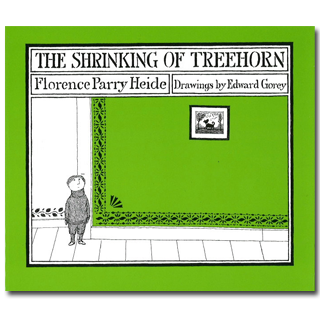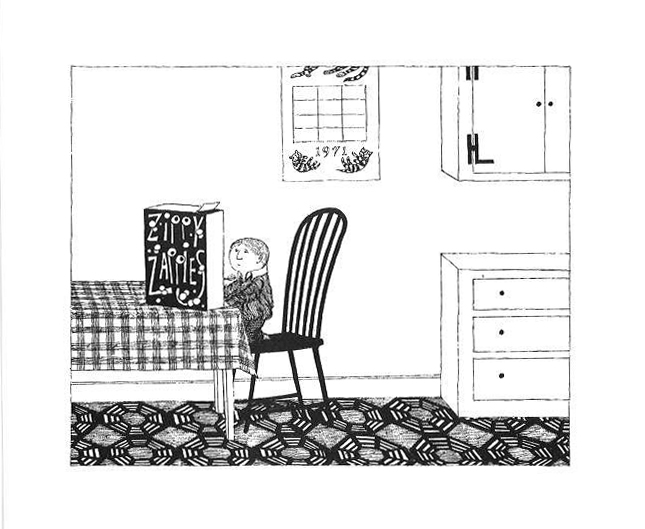
A FEW OTHER EVENTS FOR
FEBRUARY 22:
- It’s the birth date of Roma Gans (1894–1996), Let’s-Read-and-Find-Out Science book series, Harry Kullman (1919–1982) The Battle Horse, and Edward Gorey (1925–2000) The Gashlycrumb Tinies, Old Possum’s Book of Practical Cats.
- Senator Edward M. Kennedy (1932–2009) was born on this day. Read My Senator and Me: A Dog’s-Eye View of Washington, D.C. by Edward Kennedy, illustrated by David Small. It’s also Walking the Dog Day, though dogs should have the chance to go for a good walk every day!
- Happy birthday North Dakota, South Dakota, Montana, and Washington, which all became states on this day in 1889.
Born in Chicago on February 22, 1925, Edward St. John Gorey briefly attended the Art Institute of Chicago but actually received a B.A. from Harvard in French. He began his career as a book jacket designer and became a staff artist at Doubleday. Around that time, Gorey started publishing illustrated tales, often under a pseudonym, that exhibited a dark or macabre view of reality. But he always maintained that he simply followed in the nonsense tradition of Edward Lear and Lewis Carroll. With his distinctive pen-and-ink illustrations he created characters—often wearing fur coats or turtleneck sweaters or dressed in mock-Edwardian style—that could be recognized immediately by his legions of fans.
Gorey became best known for his work for adults in compilations like Amphigorey and Amphigorey, Too. His opening drawing sequences still greet viewers of the PBS series Mystery. But in 1971 he paired up with writer Florence Parry Heide to create a classic picture book for children: The Shrinking of Treehorn. I first saw this book as a young reviewer for the Horn Book and have now loved it for more than forty years. In a long text, Heide presents the dilemma of young Treehorn in a very matter-of-fact style. Treehorn is having trouble reaching the table or mailbox and believes that he is shrinking. Yet his distracted mother, aloof father, annoyed teacher, and clueless principal seem not to grasp the severity of the problem. This leaves Treehorn to face the reality of his shrinking alone. Fortunately, he finds the cause, takes action, and is restored to his former size. But like most classic children’s book protagonists, Treehorn has changed in the course of the narrative. When he discovers that he may be turning green, he decides not to let anyone know because they won’t notice anyway.
This common childhood concern, that adults really don’t pay attention to what bothers children, has been given visual interpretation in Gorey’s pen-and-ink sketches. Treehorn is such an odd child, and everyone around him so normal, that often the reader internally questions what might be happening. Is this just the problem of a child with an overactive imagination? Or is Treehorn really shrinking?
Gorey himself remained an aloof and fey character, hard to pin down. Hence I was delighted to pick up a book edited by Peter F. Neumeyer, Floating Worlds: The Letters of Edward Gorey & Peter F. Neumeyer. Reproducing the correspondence of the two men that began in 1969, the book includes a very insightful introduction by Neumeyer and then explores the two books they created together along with a great deal about Gorey’s thoughts and life. Anyone hunting for the elusive Edward Gorey will find lots of material to celebrate in this compilation of letters.
So happy birthday to Edward Gorey. His life stands as a testament to all artists—he never wavered from his own singular vision.
Here’s a page from The Shrinking of Treehorn:
 The next morning Treehorn was still smaller. His regular clothes were much too big to wear. He rummaged around in his closet until he found some of his last year’s clothes. They were much too big, too, but he put them on and rolled up the pants and rolled up the sleeves and went down to breakfast.
The next morning Treehorn was still smaller. His regular clothes were much too big to wear. He rummaged around in his closet until he found some of his last year’s clothes. They were much too big, too, but he put them on and rolled up the pants and rolled up the sleeves and went down to breakfast.
Treehorn liked cereal for breakfast. But mostly he liked cereal boxes. He always read every single thing on the cereal box while he was eating breakfast. And he always sent in for the things the cereal box said he could send for.
Originally posted February 22, 2013. Updated for .













Anita, this is one of my favorite books of all time, both for text and illustration. Whoever combined Heide and Gorey should get a gold medal.
I, too, have the Neumeyer/Gorey letters. Now I just have to find time to read them! It’s a beautiful book.
I’ve been a fan since I was a little girl and watched Mystery with my parents. His illustrations on the covers (and interiors?) of the John Bellairs books contributed to their spooky tone. I haven’t read The Shrinking of Treehorn, but it’s now on my list. I recall hearing there’s an Edward Gorey museum somewhere – or maybe it was a traveling exhibit I’d heard about. Do you know about something like that? I’d love to take my daughter.
Laura: The Edward Gorey House, Museum, is in Yarmouthport, MA, on Cape Cod. I myself have not been but Gorey fans love going there.
I like the details of Ursula Nordstrom’s attempts to work with Gorey in DEAR GENIUS. It sounds like he even perplexed her!
I just bought THE WORLD OF EDWARD GOREY by Ross and Wilkin. There’s an interesting interview with Gorey in which he details his influences, his artistic loves and hates, among other things. Perhaps appropriately, the interview ends abruptly.
There is also an essay by Karen Wilkin and pages and pages of Gorey’s art. But really, I got it for the interview. 🙂